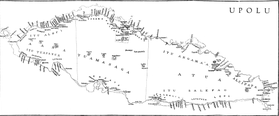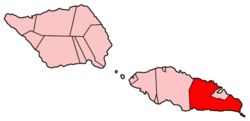Atua (district)
Ātua is an ancient political district of Samoa, consisting of most of the eastern section of Upolu. Ātua is ruled by the Tui Ātua together with the group of six senior orators of Lufilufi and 13 senior matai from throughout Ātua, comprising the Fale Ātua (or parliament of Atua). The fono (meeting) of Atua's rulers takes place in Lufilufi on the great malae of Lalogafu'afu'a. [1]
Ancient Principality of Samoa.
Ātua | |
|---|---|
 Ātua, comprising the eastern third of Upolu Island on map of 1924 | |
 Map of Samoa showing Atua district | |
| Country | |
| Government | |
| Population (2016) | |
| • Total | 22,769 |
| Time zone | +13 |
The paramount pāpā title and sovereign of Ātua is the Tui Ātua. The title traces its lineage to Pili, son of Tagaloa-a-lagi. The first Tui Atua was Tui Atua Leutelele'i'ite of Falefa, who according to oral tradition, is said to have been part aitu (god-like) and part tagata (human-like). He lived around 1170 AD. It is from his lifetime that the known pre-European history of Samoa associated with the Tui Ātua and its holders began.[2] The current Tui Ātua is former Prime Minister, Head of State and tama-a-aiga, Tui Atua Tupua Tamasese Efi.
The two paramount matai titles of Ātua are the two Tama-a-aiga titles of Tupua Tamasese and Matā'afa, respectively belonging to the two main noble lineages of Ātua: Sā Fenunuivao (descendants of Tupua) of Falefa and Salani; and Sā Levālasi (descendants of Levalasi, mother of Salamasina) of Amaile and Lotofaga.
History
According to one legend, Tagaloa-a-lagi (Samoan's supreme god), entered Upolu, Savai'i and Tonga from Manu'a island on the eastern tip of the Samoan archipelago.[3] The political divisions of Upolu are said to be traced to his son, Pili. Pili had three sons - Tua, 'Ana (who were twins) and Saga, after whom the political divisions of Upolu are named. Tua founded the political district of Ātua (literally, 'that of Tua'), which comprised the eastern third of Upolu island. 'Ana founded Ā'ana ('that of Ana), a political district on the western third of the island. The third son, Saga, was born after the twins and so the district he founded was called Tuamasaga ('after the twin').[2] This was the geographical region between Ā'ana and Ātua districts. Since then, the three political districts of Upolu have been called Ātua, Ā'ana and Tuamasaga.
Governance
The Tui Atua governs from his traditional residence at Mulinu'ū ma Sepolata'emo, in Lufilufi, the capital of Ātua. Lufilufi itself is governed by the Faleono (House of six) orator group, who are vested with the authority to appoint the Tui Atua and whose authority is reflected by its title as Matua o Ātua, (the head, or elder of Ātua). These six tulafale also summon the Fale Atua (what can be called the 'parliament' of Ātua), to ascertain its members views on a prospective holder of their papa title when the title is vacant. This 'parliament' comprises the six tulafale of Lufilufi and 13 other matai of Ātua. Of those 13 matai, nine are tulafale and four are ali'i. The members of Ātua's governing parliament form an exclusive group, as only the most senior matai in Ātua can sit in it. [2]
The Fale Atua ('parliament of Atua') decide with the Tui Ātua in matters of war and state. The Fale Atua comprises the six orators of Lufilufi as well as the respective rulers of Falefā, Solosolo, Luatuanu'u. Samusu, Lotofaga, Saoluafata and also Lepā.
Holders of the Tui Atua: From Queen Salamasina to Tupua Tamasese Efi
The line of Tui Atua extends far back into the early history of Samoa, beyond that of Queen Salamasina's reign, to the sons of Pili, descendant of the Tui Manu'a (sovereign of Manu'a). According to legend, Tagaloa-a-lagi (Samoan's supreme god), entered Upolu, Savai'i and Tonga from Manu'a island on the eastern tip of the Samoan archipelago. The political divisions of Upolu are said to be traced to his son, Pili. Pili had three sons - Tua, 'Ana (who were twins) and Saga, after whom the political divisions of Upolu are named. Tua founded the political district of Ātua (literally, 'that of Tua'), which comprised the eastern third of Upolu island. 'Ana founded Ā'ana ('that of Ana), a political district on the western third of the island. The third son, Saga, was born after the twins and so the district he founded was called Tuamasaga ('after the twin'). This was the geographical region between Ā'ana and Ātua districts. Since then, the three political districts of Upolu have been called Ātua, Ā'ana and Tuamasaga.[2]
From the first Tui Atua to Queen Salamasina and then from her to her descendants, the title has passed down along these lineages according to the prevalent power of the time. Here is the list of Tui Atua from the time of Tafa'ifā Salamasina onwards:
- Tui Atua Salamasina
- Tui Atua Taufau
- Tui Atua Faumuina
- Tui Atua Fonoti
- Tui Atua Muagututi'a
- Tui Atua Tupua Fuiavailili
- Tui Atua Afoafouvale
- Tui Atua Galumalemana
- Tui Atua I'amafana
- Tui Atua Safeofafine
- Tui Atua Malietoa Vainu'upō
- Tui Atua Malietoa Molī
- Tui Atua Mata'afa Fagamanu
- Tui Atua Sualauvi
- Tui Atua Tupua Tamasese Titimaea
- Tui Atua Mata'afa Lauifi
- Tui Atua Tupua Tamasese Lealofi-o-a'ana I
- Tui Atua Tupua Tamasese Lealofi-o-a'ana II
- Tui Atua Tupua Tamasese Lealofi-o-a'ana IV
- Tui Atua Tupua Tamasese Efi
Salutations: The Great Honours of Atua
'O le ao tetele o Atua
Tulouna 'oe Lufilufi
tulouna 'oe le Tumua
tulouna lo outou Faleono
tulouna le afio o le Tui Atua
ma Tupa'i ma Ta'inau
tulouna 'Togia'i, 'o le Tui Atua ave au malaga ia te oe, Lufilufi pe a lafalafatūga
tulouna Leausa ne itu'au ai e alataua ai
tulouna ao o Atua
tulouna uso o Atua
tulouna i'u o Atua
tulouna le fetalaiga a Tuu'u na itu fā ai Atua
tulouna le āiga Sā Levalasi
tulouna le āiga Sā Fenunuivao
tulouna a tulaniu o Atua.
Population
The district has a population (2016 Census) of 22,769.
References
- Kramer, Augustin (2000). The Samoa Islands: An Outline of a Monograph With Particular COnsideratio of German Samoa. University of Hawaii Press.
- So'o, Asofou (2008). Democracy and Custom in Samoa: An uneasy alliance. Suva, Fiji: IPS Publications, The University of the South Pacific. p. 2. ISBN 978-982-02-0390-7.
- Meleisea, M. 1987b. 'Ideology in Pacific Studies: A personal view' , In: A Hooper, et al., eds., Class ad Culture in the Pacific. Centre for Pacific Studies, University of Auckland, NZ and Institute of Pacific Studies, University of the South Pacific, Fiji.